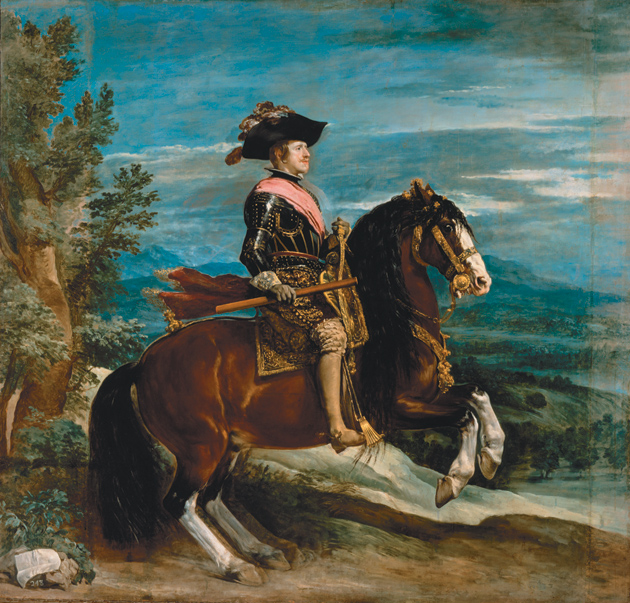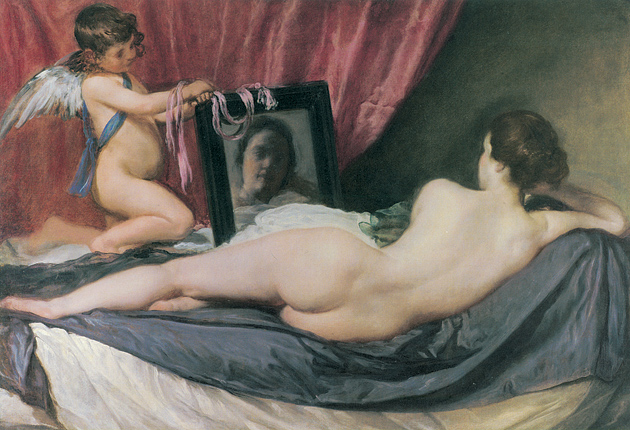“C’est le peintre des peintres.” Such was Édouard Manet’s homage after seeing Diego Velázquez’s work in the Prado in 1865. It was the era of France’s craze for all things Spanish, but Romantic enthusiasm for the Spain of opera and passionate adventure was not what interested the painter of Olympia. The murkiness of Jusepe de Ribera and the melodrama of Bartolomé Esteban Murillo were foreign to Manet’s nature. But in Velázquez he discovered an artist who refrained from all sentimentality—from all empathy, in fact—an artist who was neither garrulous nor allegorical, who did nothing but depict. It is one of the most productive paradoxes in the history of painting: Manet, the painter of modern life, who recorded the fashions and mute dramas of liberal, urban society recognizes an older brother in the court painter of Habsburg Spain. Returning to Paris, he modeled a portrait of the actor Rouvière as Hamlet on one of Velázquez’s portraits of jesters. Velázquez, whose work had been largely unknown outside of Spain until then, joined the pantheon of European painters.
Thus a tribute to “the painter’s painter” Velázquez on the 350th anniversary of his death does well to begin with the words of that other painter, who discovered the Spanish master with the intelligence of his eyes.
There are hardly any stories to tell about him. He was born in Seville in 1599, and from his twenty-fourth year on, he was a cog in the court machinery of Madrid. The court was not a place to foster anecdotes or legends about artists. We hear of his rise to increasingly lofty offices with more and more generous salaries to match. His career began in 1623 when he was named pintor del rey, and culminated in 1652 in his appointment as aposentador mayor de palacio—chamberlain of the palace. The higher he rose, the more time and energy his court duties required. As aposentador he was responsible for distributing the immense royal collections of paintings, tapestries, and sculptures. José Ortega y Gasset remarked ironically, “Velázquez is the painter whose peculiarity is that he doesn’t paint.” He pursued painting as a court office. At court, where all personal emotion is subjugated to ceremony, the artist too must avoid any expressive extravagance.
That’s why Velázquez’s pictures elude subjective empathy. You cannot get on familiar terms with them, but only admire their colorful polish from afar. They stand before the observer like a sovereign granting an audience. I recall talking with the great and judicious art historian Walter Friedländer about our visits to the Prado. We spoke with warm enthusiasm about the Titians and the Rubenses. His only comment on Velázquez was “I didn’t come close.”
Before he arrived at court, Velázquez spent his apprenticeship and early working years in Seville. The Andalusian city was a center of Spanish painting, which was financed primarily by commissions from the pious monasteries, as the work of Francisco Zurbarán almost oppressively demonstrates. Here Velázquez was apprenticed until 1617 to the painter Francisco Pacheco, known to posterity more for his writings on art theory than for his prosaic pictures. He probably both taught the young Velázquez the technical aspects of painting and introduced him to the world of books and scholarship.
His apprenticeship over, he painted what the Seville art market demanded: altarpieces for churches, portraits, but above all bodegónes—kitchen scenes. The future court painter begins with the humblest genre of professional painting: scenes from the daily life of the people. He shows them cooking, eating, pouring the water that was such a precious resource in the heat of Andalusia. The comic scenes we find in Flemish genre paintings are replaced by a hushed solemnity. Loud, bright colors are avoided. Earth tones predominate: gradations of brown, beige, and dull green. “Peintre de terre“—painter of the earthy—is what Prosper Mérimée called Velázquez. He brought to courtly art the experience of ennobling everyday life through painting.
Philip IV was crowned king of Spain in 1621 at the age of sixteen. Gaspar de Guzmán, Count-Duke of Olivares, became his powerful prime minister and Velázquez was one of the Sevillians he brought to court with him. The young painter was immediately chosen to be the King’s exclusive portraitist, just as Apelles was for Alexander the Great. By 1624, he had already painted his first formal portrait of the monarch, full-length and life-size.1 We are not facing the King but looking up at him. He is dressed all in black without flamboyance or insignia, only a chain with the Order of the Golden Fleece around his neck. His face, with its characteristic “Habsburg lip,” remains devoid of strong accents. One is tempted to read there a phlegmatic royal power, bored and lonely.
Advertisement
The court painter was required to paint the King again and again. The face and posture change very little. But by the time Velázquez painted him in 1632 in a rich brown costume with silver trim, the painter had met Rubens, been to Italy, and had his eyes opened by Titian. Now the calm figure of the monarch is surrounded by a shimmer of sparkling color. But even this portrait has nothing really powerful about it, rather something dreamy and enchanted. It was the painter’s job to portray the roles the King chose to play. For the hunting lodge Torre de la Parada he painted a likeness that portrays the ruler as a hunter. He again appears full-length, with rifle and dog, but in markedly simple dress. And so the palette of the early genre paintings reappears on the royal portrait in exquisite tones of beige and brown. After the hunter comes the general. In 1646, when Philip was with his troops in Fraga, Velázquez painted him in a red costume trimmed in silver and put a field marshal’s baton in his hand. But there is always something Hamlet-like, refracted, surrounding the figure of this king. The painter, who sometimes had the reputation of being a phlegmatic and melancholy man himself, savors this shy ambiguity in his quiet portraits. He is a realist of extreme subtlety.
The highest level of royal portraiture is the equestrian portrait. In Madrid Velázquez could see with his own eyes a consummate example: Titian’s 1548 portrait of Emperor Charles V at the Battle of Mühlberg. For the Salón de Reinos in the Buen Retiro Palace in Madrid, Velázquez painted an equestrian portrait of Philip IV that is a coloristic masterpiece. We see the King in sumptuous armor with a red sash and marshal’s baton, riding a horse in levade position high above his domains. It’s less an image of warlike threat than a virtuoso play with the ritualized glamour of the general’s role. In the same salon hung Velázquez’s Surrender of Breda, an unforgettable painting celebrating the taming of the fury of war by the virtues of chivalry.
Velázquez, however, painted not just the King but the entire court. Infante Baltasar Carlos, although still a child, is portrayed as a hunter and a mounted commander. Such paintings make the fictionality of court role-playing more than abundantly clear. Then one comes upon portraits of the Infante Ferdinand, the King’s brother—sober, indolent refractions of the images of the monarch. Velázquez also painted several portraits of Olivares—the prime minister, the careerist—in more swaggering poses than those of his master.
At the end of Velázquez’s career came the portraits of the Queen and the infantas in which the painter captures the sumptuousness of their costumes, the shimmer of silver braid against black or blue, the sheen of the material. The princesses appear as motionless figures on the stage of courtly ceremony. What is central to the incomparable beauty and magic of these portraits is the forlorn and even tragic aspect of the figures. They were bait, pawns in the political alliances between states. And for that, the seductive art of the painter was required.
Jesters were also an integral part of the court, their function being to subject the rulers’ pride to ridicule. And they also sat for the court painter. In one astonishing full-length portrait, a bufón travesties the pose struck by Juan de Austria after his victory at the Battle of Lepanto. He is stooped, his weapon, helmet, and cuirass are scattered on the ground, and his costume flaps loosely about him: Victoria is a mere caprice of Fortuna, military fame an ephemeral farce. Chasms yawn beneath the surface of courtly art. In works of smaller format, we encounter the royal dwarfs. Here court etiquette dissolves into deformation, derision, and mental debility. Velázquez’s palette becomes dirty. The painter of the bodegónes has arrived at the lowest stratum of court society. Nothing would be more fallacious than to read sympathy or sensitivity into these grotesque likenesses. The absolutist court was a menagerie encompassing all of human nature from king to dwarf, and painting was its mirror.
Since Velázquez was a court official and did not paint for the private market, his work seldom oversteps a narrowly circumscribed set of themes. It is unusual how few religious paintings he made. In the case of a painful picture in shades of gray showing the flagellated Christ and a childish figure kneeling next to him in contrition and humility, we know neither who commissioned it nor where it was to hang. The altarpiece of a chapel on the grounds of Buen Retiro shows the hermit saints Paul and Anthony in a landscape inspired by Joachim Patinir. Spain had almost no part in the flowering of European landscape painting. For Velázquez also, this remained alien territory. But during his sojourn in Rome he painted two views of the grounds of the Villa Medici, apparently for his own amusement since nothing could be further removed from the ideal landscapes then prized in Rome. A hundred years before Fragonard and Hubert Robert, the Spaniard captured the enchanted atmosphere of a Roman garden.
Advertisement
Just as infrequent are his mythological canvases. There we find his daring and slightly risqué response to Titian: the reclining Venus looking at herself in a mirror held by Cupid. This chromatically seductive tableau stages a sophisticated competition between what is revealed and what is hidden. We see only the back of the beautiful goddess and only a shadowy reflection of her face. The viewer becomes a secret voyeur. She doesn’t see us and we cannot see her most intimate secrets.
Other mythological paintings are more earthy. The deliciously vital painting known as Los Borrachos (The Drunkards), which became the painter’s most popular work, shows the wine god Bacchus surrounded by Spanish peasants; it’s like a scene from Buñuel’s Viridiana. In another painting, the sun god Apollo enters Vulcan’s sooty forge to tell the dumbstruck smith of his wife’s infidelity. We see shades of brown and gray as in the bodegónes; the motif is from Ovid but such a picture is worlds away from the learned antiquarianism of Poussin or Rubens. The ancient world has reappeared among peasants and artisans. Is the cuirass on the floor of the smithy meant for Mars the adulterer?
Velázquez also painted a mysterious Mars for Torre de la Parada. His weapons have slid to the floor, he has thrown off his colorful robes, and only his helmet is still on his head. He sits in shadow, sunk in thought. Is the ancient god being made fun of? Not at all: we’re not in the world of Daumier or Heinrich Heine. In this dream vision of a disarmed Mars in contemplative melancholy, a war-ravaged age yearns for peace.
Although Velázquez’s appointment as palace chamberlain in 1652 restricted his time for painting, it was then that he painted his most famous pictures, Las Hilanderas (The Spinners) and Las Meninas (The Maids of Honor). Both works have to do with the status of art, and therefore Velázquez painted more delicately than ever before. The German art historian Carl Justi called Las Hilanderas “one of the first portrayals of factory workers.” But behind and two steps higher than the toiling spinners a second, festively illuminated room opens to the viewer. There Arachne (according to Ovid “renowned not for her birth or standing, but only for her art”) triumphs over the goddess Athena in a spinning contest. Art bridges divisions between classes and even between gods and men. The court painter declares his allegiance to its freedom.
With Las Meninas, we return to the court. In a cavernous and twilit room of the royal palace stands the five-year-old Infanta Margarita, attended by maids of honor and accompanied by dwarfs and a dog. More extras loom in the background. On the rear wall hangs a mirror in which the images of the King and Queen can be discerned. Have they just entered the room, attracting the eager attention of the infanta and the dwarf? It seems so, but is it really so? The most imposing figure in the picture is the court painter, standing with brush and palette before a canvas, a canvas we see only from behind. What is he painting? The infanta? The royal couple? It is, as Justi wrote, “a picture about the creation of an (invisible) picture.” But it is also a self-portrait of the court painter, of his role, his rise, his artistic dexterity in service to the throne, his wizardry. The drama of Spanish court ritual is a distant phantom, an empty social pantomime. Only its reflection lives on in Velázquez’s liberated art.
This Issue
September 30, 2010
-
*
Editors’ note: This and many of the other paintings mentioned in this article are illustrated in Velázquez, edited by Dawson W. Carr (National Gallery Company/Yale University Press, 2006). ↩




